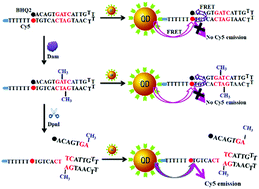Advances in single quantum dot-based nanosensors
Abstract
Single-molecule detection provides a simple and ultrasensitive platform to quantify target molecules by simply counting the individual fluorescence signals. Quantum dots (QDs) are novel semiconductor nanocrystals with distinct characteristics of high brightness, large Stokes shift and broad absorption spectra, high molar extinction coefficients, high quantum yield, good photostability and long fluorescence lifetime. The combination of single-molecule detection with QDs enables the development of single QD-based nanosensors with extremely high sensitivity. Single QD-based nanosensors may be divided into two categories based on single QD burst coincidence detection and single QD-fluorescence resonance energy transfer (FRET) detection, and have significant advantages of high signal-to-noise ratio, high sensitivity, rapidity, and low sample consumption. The single QD-based nanosensors have the capability of directly detecting low-abundance species without the need for nucleic acid amplification, and may elucidate a variety of biological and biochemical phenomena in real time using single QD tracking. In this review, we summarize the recent advances in single QD-based nanosensors and their applications for sensitive detection of DNAs, microRNAs, proteins, enzymes, small molecules and viruses. We highlight the challenges and future direction of single QD-based nanosensors as well.



 Please wait while we load your content...
Please wait while we load your content...